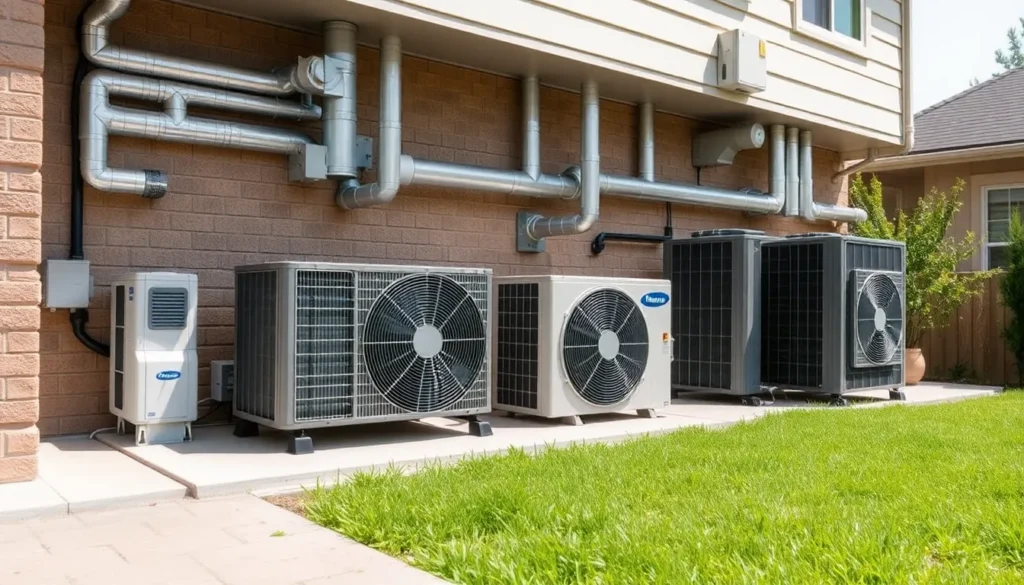Table of Contents
ToggleWhen it comes to heating and cooling, understanding BTUs and tons can feel like deciphering a secret code. But fear not, because cracking this code is easier than finding a cat video on the internet. In the world of HVAC, one ton of cooling capacity equals a whopping 12,000 BTUs. Yes, you read that right—12,000!
Understanding BTUs and Tons
BTUs and tons represent critical measurements in the heating and cooling sectors, especially within HVAC systems. One ton equals 12,000 BTUs, highlighting the relationship between these two units.
What Are BTUs?
BTUs, or British Thermal Units, refer to the amount of energy needed to raise the temperature of one pound of water by one degree Fahrenheit. This unit captures thermal energy across various contexts, including home heating, cooling, and appliance efficiency. By evaluating energy consumption, individuals assess the effectiveness of their HVAC systems. Professionals often use BTUs to rate the heating and cooling capacities of equipment, ensuring optimal performance for specific spaces.
What Is a Ton?
A ton in heating and cooling terms signifies the cooling capacity required to melt one ton of ice in a 24-hour period. Each ton corresponds to a significant cooling power of 12,000 BTUs. Systems rated in tons indicate their efficiency in removing heat from indoor environments. Understanding this measurement helps consumers choose appropriate HVAC solutions for their specific needs. Properly sized systems enhance comfort while managing energy costs effectively.
The Conversion Between BTUs and Tons

Understanding the conversion between BTUs and tons simplifies the selection of HVAC systems. One ton of cooling capacity represents 12,000 BTUs.
How to Calculate BTUs in a Ton
To calculate BTUs in a ton, multiply the tonnage by 12,000. For example, a five-ton system offers 60,000 BTUs, derived from 5 tons times 12,000 BTUs per ton. This calculation is essential for evaluating energy efficiency and ensuring proper sizing of heating and cooling equipment. Accurate measurements guarantee optimal comfort levels in residential and commercial spaces.
Common Applications of This Conversion
This conversion finds use in various fields, including residential HVAC design, commercial building sizing, and equipment specification. Homeowners often rely on BTU measurements to select the right air conditioning unit. Additionally, contractors utilize these values when recommending systems to ensure the best performance. In commercial settings, accurate calculations allow businesses to manage energy expenses effectively and maintain climate control.
Importance of Knowing BTUs in a Ton
Understanding the relationship between BTUs and tons is crucial for effective heating and cooling. This knowledge directly influences HVAC system performance and efficiency.
Impact on HVAC Systems
Selecting the appropriate cooling capacity in an HVAC system hinges on accurately determining BTUs in a ton. A mismatch in sizing can lead to inefficient operation, higher energy costs, and inadequate temperature control. Professionals rely on the 12,000 BTU per ton standard to ensure systems meet environmental demands. Consequently, proper sizing enhances system longevity and customer satisfaction. Furthermore, accurately calculated BTUs promote optimal airflow, reducing humidity levels and improving overall indoor comfort.
Energy Efficiency Considerations
Energy efficiency plays a significant role in HVAC planning, with BTUs serving as a critical measurement. Knowledge of BTUs informs calculations for system capacity, ensuring minimal energy wastage. For instance, a well-sized system reduces energy consumption and promotes environmental sustainability. Accurate assessments contribute to lower utility bills and prolong equipment life. Selecting systems designed with efficient BTU ratings also fulfills energy regulations and certifications, thereby increasing property value. Additionally, leveraging technology like programmable thermostats can further optimize energy usage based on BTU requirements.
Understanding the relationship between BTUs and tons is vital for anyone looking to optimize their HVAC system. With one ton equating to 12,000 BTUs it becomes easier to select the right cooling capacity for specific needs. Proper calculations ensure that systems operate efficiently and effectively which is key for maintaining comfort and managing energy costs.
Investing time in understanding these measurements can lead to significant benefits including reduced energy consumption and enhanced indoor climate control. As technology continues to advance homeowners and businesses alike can leverage this knowledge to make informed decisions that not only improve comfort but also contribute to energy savings and sustainability.




